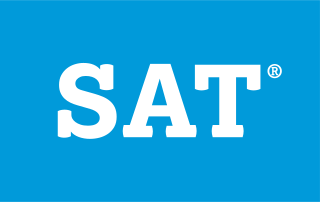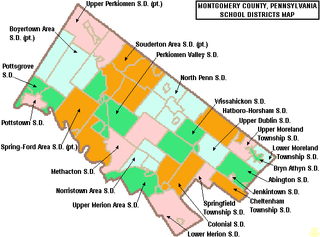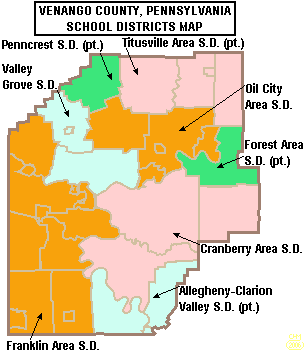
The SAT is a standardized test widely used for college admissions in the United States. Since its debut in 1926, its name and scoring have changed several times. For much of its history, it was called the Scholastic Aptitude Test and had two components, Verbal and Mathematical, each of which was scored on a range from 200 to 800. Later it was called the Scholastic Assessment Test, then the SAT I: Reasoning Test, then the SAT Reasoning Test, then simply the SAT.

The No Child Left Behind Act of 2001 (NCLB) was a U.S. Act of Congress that reauthorized the Elementary and Secondary Education Act; it included Title I provisions applying to disadvantaged students. It supported standards-based education reform based on the premise that setting high standards and establishing measurable goals could improve individual outcomes in education. The Act required states to develop assessments in basic skills. To receive federal school funding, states had to give these assessments to all students at select grade levels.
Achievement gaps in the United States are observed, persistent disparities in measures of educational performance among subgroups of U.S. students, especially groups defined by socioeconomic status (SES), race/ethnicity and gender. The achievement gap can be observed through a variety of measures, including standardized test scores, grade point average, dropout rates, college enrollment, and college completion rates. The gap in achievement between lower income students and higher income students exists in all nations and it has been studied extensively in the U.S. and other countries, including the U.K. Various other gaps between groups exist around the globe as well.
Adequate Yearly Progress (AYP) was a measurement defined by the United States federal No Child Left Behind Act that allowed the U.S. Department of Education to determine how every public school and school district in the country was performing academically according to results on standardized tests. As defined by National Council on Measurement in Education (NCME), AYP was "the amount of annual achievement growth to be expected by students in a particular school, district, or state in the U.S. federal accountability system, No Child Left Behind (NCLB)." AYP has been identified as one of the sources of controversy surrounding George W. Bush administration's Elementary and Secondary Education Act. Private schools were not required to make AYP.
Biotechnology High School (BTHS), or commonly referred to as Biotech, is a four-year comprehensive vocational public high school serving students in ninth through twelfth grades in Freehold Township, Monmouth County, United States, as part of the Monmouth County Vocational School District (MCVSD). Its curriculum includes a science program, consisting of eight different science classes spread over four years, designed to prepare students to pursue further education in biotechnology and the natural sciences. Emphasis is placed on research, laboratory skills, critical thinking, problem solving, technology, and teamwork. Over 90% of the 2009 graduates selected college majors in the life sciences. The school has been accredited by the Middle States Association of Colleges and Schools Commission on Elementary and Secondary Schools since 2005.

Jeffersonville High School is a public high school located in Jeffersonville, Indiana. The school serves students in grades 9 through 12 from Jeffersonville, Utica, and sections of Clarksville not covered by that town's own high school. The school's enrollment for the 2014–2015 school year was 2,051 students, with 123 teachers. The current principal is Pam Hall. Jeffersonville is in the school district of Greater Clark County Schools. This school district includes Charlestown addresses that are connected with the city of Jeffersonville. While most schools in other counties have a majority European ratio of students, Jeffersonville total minority enrollment is 36%.
The Union County Academy for Allied Health Sciences (UCAAHS) is a full-time Vocational public high school, located in Scotch Plains, in Union County, New Jersey, United States. This school serves students in ninth through twelfth grades from across Union County as a career academy on the Union County Vocational Technical Schools Campus, which also includes the Academy for Information Technology, Union County Magnet High School, Academy for Performing Arts, and the Union County Vocational Technical High School. The school has been accredited by the Middle States Association of Colleges and Schools Commission on Elementary and Secondary Schools.
Grade inflation is the awarding of higher grades than students deserve, which yields a higher average grade given to students.

Souderton Area School District is a large, suburban public school district which covers an area of almost 50 square miles (130 km2) in the Montgomery County and Bucks County suburbs of Philadelphia. The district serves the municipalities of Souderton, Telford, Franconia, Lower Salford, Upper Salford, and Salford. By 2021, the population of the district was 47,277. The Souderton Area School District operates 3 secondary schools and 6 elementary schools. A new high school was built on Lower Road and was occupied in September 2009.
The Pennsylvania System of School Assessment (PSSA) is a standardized test administered in public schools in the state of Pennsylvania. Students in grades 3-8 are assessed in English language arts skills and mathematics. Students in grades 4 and 8 are also assessed in skills relating to natural science, including the field of data interpretation and analysis. Since 2013, high school students have taken the Keystone Exam in place of the PSSA for their standardized testing. The PSSA's were made by a company in New Jersey. The PSSA is written, owned and administered by Pearson Education. There are reporting categories for each subject which list eligible content to be tested in each grade. Assessment Anchors specify what is considered eligible content for each grade level tested. A Proficient or Advanced level is needed to be able to qualify as passing the PSSA.
Beaver Area High School is a public high school in Beaver, Pennsylvania, United States. It is the only high school in the Beaver Area School District. Athletic teams compete as the Beaver Bobcats in the Western Pennsylvania Interscholastic Athletic League.

The Octorara Area School District is a small, rural–urban fringe, public school district serving Parkesburg, Atglen, Christiana, West Sadsbury Township, Sadsbury Township, West Fallowfield Township, Highland Township, and Londonderry Township in Pennsylvania.

The Cranberry Area School District is a small, rural, public school district which serves the residents of Cranberry Township, Pinegrove Township and Rockland Township in Venango County, Pennsylvania. Cranberry Area School District encompasses approximately 155 square miles (400 km2). According to 2000 federal census data, it serves a resident population of 9,698. In 2009, the per capita income of district residents was $16,307, while the median family income was $39,203 a year. In the Commonwealth, the median family income was $49,501 and the United States median family income was $49,445, in 2010. Per school district officials, in school year 2007-08 the Cranberry Area School District provided basic educational services to 1271 pupils through the employment of 115 teachers, 77 full-time and part-time support personnel, and 7 administrators. In 2006, the 1,308 student population was 98% white, 1% black, 1% Asian, Native American <0.1% and <0.2% Hispanic. The Cranberry Area School District received more than $9 million in state funding, for school year 2007-08.

The math–verbal achievement gap is a phenomenon first observed by Richard Rothstein in a brief 2002 article written in The New York Times. This achievement gap reveals a growing disparity in the United States between the rising national average on the math portions of the college entry SAT and ACT exams, as opposed to the flat-lining verbal portions on the same tests.
Weir Senior High School is a secondary public high school in the town of Weirton, West Virginia. It was established in 1916. Today, Weir High School is home to roughly 510 students in grades 9 through 12. It is a part of the Hancock County school district. The school has been named a school of excellence and a national blue ribbon school. Its curriculum is broad and consists of career clusters designed to help students determine a path of higher education.
The Partnership for Assessment of Readiness for College and Careers (PARCC) is a consortium featuring two states, the District of Columbia, the Department of Defense Educational Activity, and the Bureau of Indian Education, that work to create and deploy a standard set of K–12 assessments in Mathematics and English, based on the Common Core State Standards.
The racial achievement gap in the United States refers to disparities in educational achievement between differing ethnic/racial groups. It manifests itself in a variety of ways: African-American and Hispanic students are more likely to receive lower grades, score lower on standardized tests, drop out of high school, and they are less likely to enter and complete college than whites, while whites score lower than Asian Americans.
Medfield High School is a 9–12 public high school in Medfield, Massachusetts, part of Norfolk County, Massachusetts, United States. It is one of five public schools in the school system, and the only public high school in Medfield.
The SAT is a standardized test commonly used for the purpose of admission to colleges and universities in the United States. The test, owned by the College Board and originally developed by Carl Brigham, was first administered on June 23, 1926, to about 8,000 students. The test was introduced as a supplement to the College Board essay exams already in use for college admissions, but ease of administration of the SAT and other factors led to the discontinuation of the essay exams during World War II. The SAT has since gone through numerous changes in content, duration, scoring, and name; the test was taken by more than 1.7 million students in the graduating high school class of 2022.










